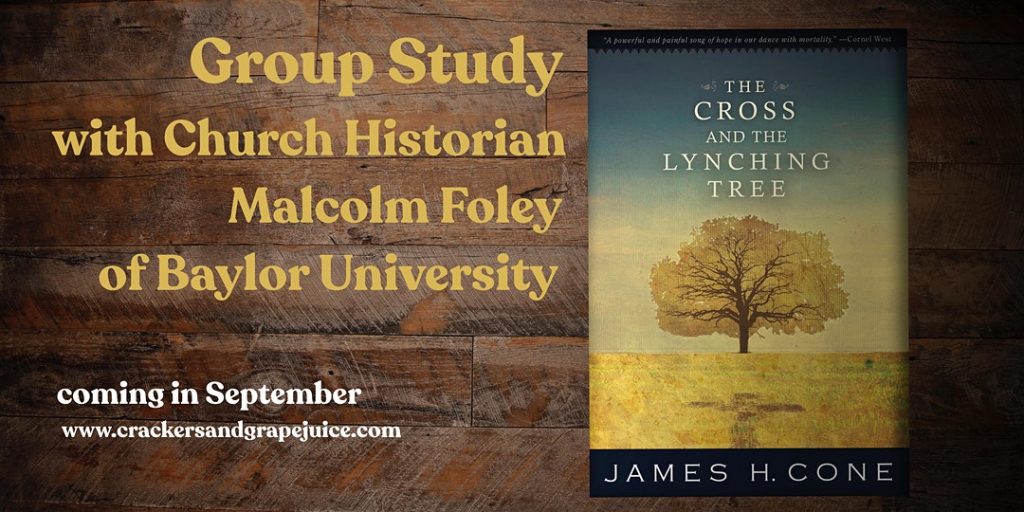Week One: 9/14
Introduction and Chapter One (“Nobody Knows de Trouble I See”)
- On page xiv, Dr. Cone states, “Unfortunately, during the course of 2,000 years of Christian history, this symbol of salvation [the cross] has been detached from any reference to the ongoing suffering and oppression of human beings…..” Do you agree?
- Did it ever occur to you to link the cross and lynchings in this country? Do you think that it is accurate to say that lynching is a “memory that most white Americans would prefer to forget?”
- Does a collective lack of remembrance lead to the “fraudulent perspective …of the meaning of the Christian gospel for this nation” as Cone claims?
- Do we sometimes forget that the Cross is a paradox because it “inverts the world’s value system with the news that hope comes by way of defeat”? (p. 2) Does reading even this far in the book renew your understanding of the cross?
- Cone says, “this dialectic of despair and hope defined black existence” (p.14). Can you think of situations today that embody this? What are some contemporary situations in the black community that might parallel the lynching era?
- The classic question of theodicy – if God is good, why does suffering exist – takes on special poignancy when considering the plight of black people in the era of lynching. What became the refuge and comfort for them during this time? Are there contemporary examples of this kind of refuge?
Week Two: 9/21
Chapter Two (“The Terrible Beauty of the Cross”)
- On page 30, Cone says that “the crucifixion was clearly a 1st c. lynching.” Discuss why he says this (see page 31 for some descriptions.)
- On page 35, Cone reflects on Reinhold Niebuhr’s “transvaluation of values”. Do you agree that Jesus was crucified because people expected a Messiah “perfect in power and perfect in goodness”? How do you see Jesus?
- On page 51, Cone asserts that Niebuhr’s failure to deal with racial issues is a serious failure by someone often called America’s greatest theologian. How well do you think the Church today treats issues of race? Discuss how your congregation is or is not addressing issues like mass incarceration, police brutality, and whatever local instances there may be of racism.
- Would you agree with Cone’s statement that “groups don’t love” (p. 53) and that, therefore, “love is the motive, but justice is the instrument.” Reflect on what this means in practical terms.
- On page 55 a Rabbi is quoted as saying, “the most tragic problem is silence.” (even more urgent that bigotry and hatred!) Do you agree? How can this quote guide our actions as congregations and as individuals?
Week Three: 9/28
Chapter Three (Bearing the Cross and Staring Down the Lynching Tree”)
- Chapter Three begins with discussion of Emmett Till. Do you think that we, as a society, know enough about Emmett Till? Did you learn new things about that terrible situation in this book? Does describing Till as a “sacrificial lamb” (p. 69) add new resonance to the story?
- Cone compares Reinhold Niebuhr and Martin Luther King, Jr. in this chapter, asserting that Niebuhr viewed Jesus’ love as an unrealizable goal – “a state of perfection which no individual or group in society could ever fully hope to achieve…..the cross was an absolute transcendent standard…and the most we can realize is “proximate justice.”” MLK, Jr., on the other hand, would not settle for what was practically possible – but, rather, called out for an idealistic pursuit of freedom. How does this comparison enhance your understanding of what the Cross means? Do you think that the saving power of the Cross can be understood rationally or is there an “eerie feeling of mystery and the supernatural?” (p. 75)
- Cone engages in an extensive explication of MLK, Jr.’s view of suffering. Do you agree that suffering can be transformed into a creative force? (p. 86) Could giving value to suffering help to legitimize it? (p. 92) Does this tension help us better understand the Cross and the hope it provides?
- On page 91, Cone says, “No matter what disappointments he faced, King still preached hope with the passion of a prophet…” How do you find hope in contemporary situations of suffering and oppression?
Week Four: 10/5
Chapter Four (The Recrucified Christ in Black Literary Imagination)
- In this chapter, Cone focuses on some of the black writers, artists and poets who have portrayed the connections between the cross and the lynching tree; those who have tried to use art to convey that delicate paradox of victory in defeat; the ultimate power of the Paschal mystery. Ask the group if they have any favorite black writers. Do you think that mainstream culture is exposed to minority writers in a way that helps broaden our perspective and deepen our understanding of contemporary events? Ask the group to identify the examples of poetry in the book that they appreciated the most.
- On page 101, we hear of an artist who painted a black Christ on the cross. Cone says, “Simply turning him from white to black switched the visual signifiers, making him one with the body of lynched black people of America.” Have you ever seen a picture like this? Do you think that creating new meaning can be this simple?
- At the end of the chapter (p. 118), Cone reconstructs a very brief “history” of black Christian tradition, saying that black slaves were cut off from their African religious traditions and only had white Christianity as a resource, but nevertheless saw the Bible as “stories of God siding with little people just like them.” How accurate do you think this interpretation of the Bible is?
- Do white theologians today agree with this? Do you think that this “commonsense” theology of the grassroots has had an influence on mainstream Christianity?
Week Five: 10/12
Chapter Five (“Oh Mary, Don’t You Weep”)
- One of the characteristics of the blues is that it speaks about the tragic and the comic, sorrow and joy simultaneously. How is this similar to our Christian faith?
- In this chapter, Dr. Cone draws attention to the fact that women, too, were victims of lynching – both directly and indirectly since when men were killed their families suffered greatly. He says, “although women constitute only 2 % of blacks actually killed by lynching, it would be a mistake to assume that violence against women was not widespread and brutal.” What other kinds of violence were women subjected to? Women, too, struggled to maintain faith in God in the midst of so much suffering and injustice. Many blacks, both male and female, identified strongly with biblical figures like Job and Jeremiah. Do you think that such identification is limited to one particular race or group? What character in scripture do you identify with? Have you changed your affinity to bible stories over time or in response to different situations in your life?
- On p. 125, we read, “The faith of black women gave them courage to fight, patience when they could not, and the hope that whatever they did, God would keep them “from sinking down.”” Various faith declarations are mentioned, like: “God may not come when you want but God is right on time” or “making a way out of no way”……Do you have a favorite faith declaration or saying?
- On p. 139, the theologian Howard Thurman is quoted as saying, “ a person has to handle…suffering or be handled by it.” If there is time, invite sharing on this idea.
- Traditional atonement theory about the cross can be problematic because it seems to lift up suffering as redemptive. Cone says, “What is redemptive is the faith that God snatches victory out of defeat, life out of death, and hope out of despair, as revealed in the biblical and black proclamation of Jesus’ resurrection.” (p.150) As you have read this book over the last few weeks, have your thoughts about the Cross and its meaning changed?
Week Six: 10/19
Conclusion: Legacies of the Cross and the Lynching Tree
- This short chapter is a pithy summary of many of the themes from the previous sections. Especially, Cone returns to the paradox of the meaning of the cross and “salvation”. He says, “The real scandal of the gospel is this: humanity’s salvation is revealed in the cross of the condemned criminal Jesus, and humanity’s salvation is available only through our solidarity with the crucified people in our midst.” (p. 160) Discuss the ramifications of this statement.
- Over and over, we hear that the cross is “an opening to the transcendent” – something that is available to all. And yet, we also need “the imagination to relate the message of the cross to one’s own social reality…..” What are some of the social realities of today that reveal the cross?
- Cone suggests that a new kind of “lynching” is taking place in the criminal justice system of our country, “where nearly one-third of black men between the ages of eighteen and twenty- eight are in prisons, jails, on parole, or waiting for their day in court. Nearly one-half of the more than two million people in prisons are black…..” (p. 163) Were you aware of this situation? (more statistics are easily available here and other sites online.) As a group, discuss what might be some steps that people of faith could take to learn more about this “lynching without a rope and a tree” and do something about it.
- Dr. Cone says, “The cross is the most empowering symbol of God’s loving solidarity with the “least of these”, the unwanted in society who suffer daily from great injustices. Christians must face the cross…and discover in it, through faith and repentance, the liberating joy of eternal salvation.” (p. 156) Do you have a vision of what the Way of the Cross means both in scripture and in the world?

